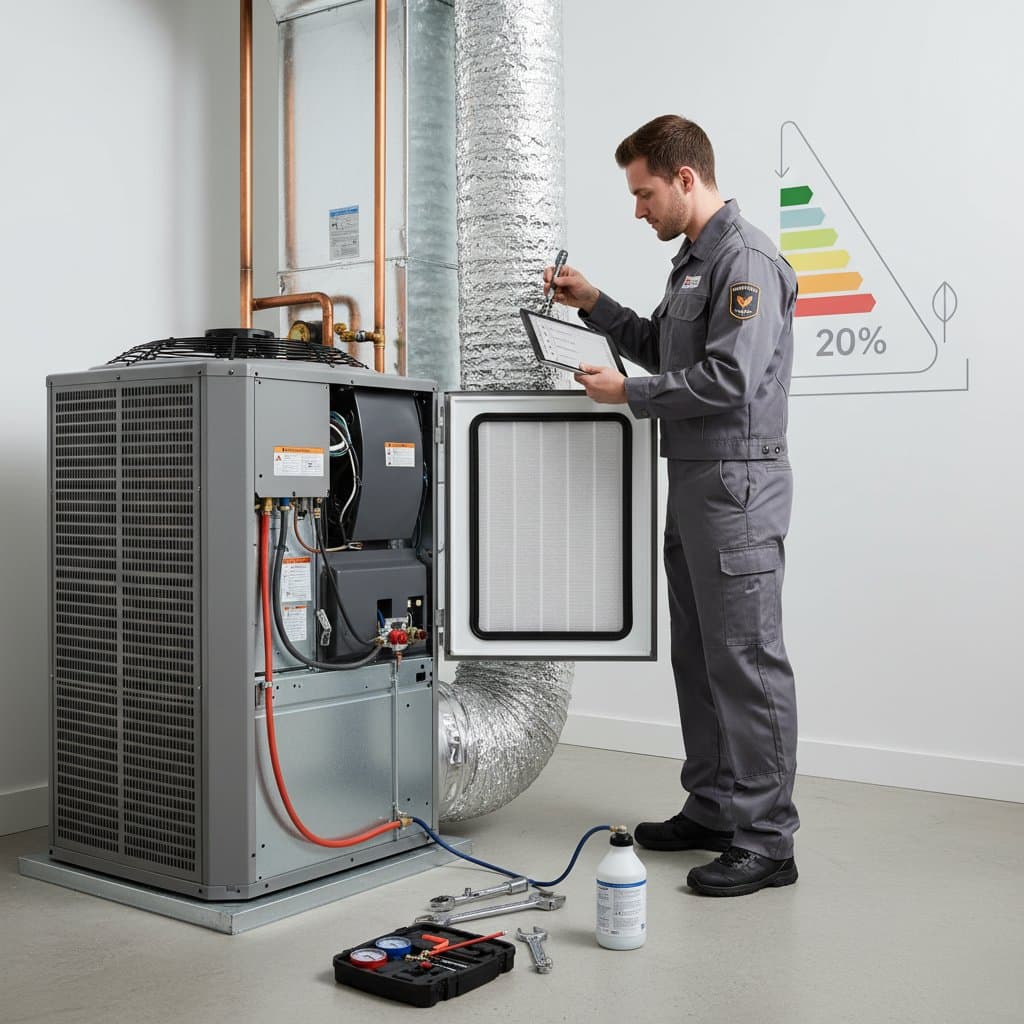Prepare Your AC Now to Avoid Summer Disruptions
A dependable air conditioner maintains comfortable indoor temperatures during intense heat. Homeowners often delay inspections until the first hot spell arrives. At that stage, minor problems escalate into major failures, leading to higher repair expenses and extended wait times for service. Proactive maintenance planning averts these issues, prolongs equipment durability, and optimizes energy use across the entire season.
AC Maintenance Cost Basics
Regular air conditioning maintenance represents a cost-effective strategy to safeguard a significant household investment. Professional tune-ups generally cost between $75 and $200 nationwide, varying by location and system type. Urban regions command higher fees due to elevated labor and operational costs, whereas suburban or rural areas provide more affordable options. Demand fluctuations impact rates as well; spring and late summer periods feature promotional pricing, but midsummer surges elevate expenses.
Broader economic factors also play a role. Fluctuations in energy costs, refrigerant supply expenses, and technician availability influence final bills. Homeowners benefit from anticipating these elements to secure appointments ahead of peak periods.
Pricing Approaches and Service Packages
HVAC providers employ diverse pricing strategies. Hourly billing suits minor adjustments, yet flat-rate structures offer budgeting certainty for routine tune-ups. For tasks like coil cleaning or filter changes, providers often apply per-item or project fees.
Bundled services prove popular among companies. Such packages combine inspections, cleanings, and filter swaps at reduced rates compared to individual bookings. Certain firms introduce membership programs with annual fees that cover periodic visits, expedited service, and repair discounts. These options suit those seeking ongoing reliability without manual scheduling.
Levels of Service and Associated Costs
Maintenance options typically divide into four levels:
-
Basic Inspection Service
This entry-level option involves a quick system review and light cleaning to verify safe operation. Technicians examine filters, test thermostats, and evaluate airflow. Fees range from $75 to $100, making it suitable for newer or recently maintained units. -
Standard Maintenance Service
Building on basics, this includes thorough cleaning, refrigerant level checks, and electrical component reviews. Most households select this for its blend of thoroughness and affordability, with costs between $100 and $150. -
Premium Comprehensive Service
Advanced diagnostics feature here, along with deep coil washing, blower maintenance, duct evaluations, and refrigerant adjustments. Expect $150 to $250, justified by enhanced efficiency and lower energy consumption. -
Specialized Custom Service
Complex setups like high-efficiency or multi-zone systems demand expert calibration and sensor analysis by certified professionals. Pricing starts at $250 and adjusts based on system intricacies.
Factors Shaping Maintenance Expenses
Multiple elements determine the overall price of yearly upkeep:
- Unit Capacity and Scale: Bigger systems require extended labor and additional supplies.
- System Design: Variable-speed or zoned configurations necessitate specialized expertise and equipment.
- Age and State: Aging units demand extra focus on wiring, motors, and refrigerant pathways.
- Access Challenges: Hard-to-reach placements, such as attics or roofs, increase labor duration.
- Booking Timing: Off-season appointments yield savings and shorter queues.
Optional Enhancements and Extra Fees
Standard tune-ups often pair with add-ons that elevate performance and reliability:
- Duct Cleaning: This clears accumulated dust, enhancing air circulation and quality; fees vary from $300 to $600 based on home dimensions and duct extent.
- Filter Upgrades: Premium filters, priced at $20 to $50 each, trap smaller contaminants and prolong equipment longevity.
- Refrigerant Replenishment: Low levels prompt recharges costing $200 to $500, using pricier modern formulas to avert compressor damage.
- Rush Service Premiums: Heatwave emergencies add $100 or more for immediate attention.
These extras promote smoother operation and minimize seasonal interruptions.
Comprehensive AC Tune-Up Checklist
Effective maintenance addresses mechanical and electrical aspects alike. Knowledge of inspection elements empowers homeowners to evaluate service depth. Top-tier visits encompass these procedures:
- Examine and cleanse condenser and evaporator coils.
- Verify refrigerant pressure and operating temperatures.
- Secure electrical connections and measure voltage levels.
- Apply lubrication to fan motors and bearings.
- Swap or refresh air filters.
- Assess thermostat precision and adjust as required.
- Flush condensate drains to eliminate blockages.
- Ensure adequate airflow over the evaporator coil.
- Scan ductwork for leaks and insulation deficiencies.
- Gauge overall system efficiency against environmental conditions.
Professional interventions boost efficiency by up to 15 percent and halve breakdown risks, per industry standards.
Advantages of Routine Maintenance Over Crisis Fixes
Urgent repairs frequently surpass routine costs by threefold or more. Compressor overhauls alone tally $1,500 to $3,000, whereas proactive motor or capacitor work remains under $500. Early care eliminates surprise failures, particularly when summer schedules overload providers.
Efficiency gains extend further. Pristine coils and balanced refrigerant enable quicker cooling with reduced electricity draw. Seasonal savings accumulate substantially on utility statements, while lessened strain on core components extends unit lifespan by years.
Choosing a Dependable HVAC Provider
Service provider selection rivals the maintenance act in importance. Seek certifications from bodies like NATE for technical proficiency or EPA Section 608 for refrigerant management. Established firms disclose pricing clearly, carry insurance, and back work with guarantees.
Online feedback and community endorsements highlight reliability. Environmentally conscious choices, such as those using sustainable refrigerants, align with efficiency goals and regulatory shifts, though initial premiums yield enduring returns.
Take Action for Seasonal Readiness
Early air conditioner preparation secures comfort, dependability, and financial benefits. Arrange a professional inspection promptly to preempt demand rushes. Maintain filters monthly, remove outdoor unit debris, and ensure indoor vents remain clear.
For aging or struggling systems, consult experts on replacement merits. Contemporary models deliver quieter performance and superior energy savings, curbing both ecological footprint and operational expenses.
Consistent upkeep transforms potential vulnerabilities into assured performance. This modest upfront effort guarantees seamless cooling as temperatures rise, free from untimely disruptions.





